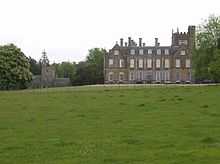Melbury House

Melbury House in Melbury Sampford near Evershot, Dorset,[1] has been the seat of the Strangways family of Dorset since the estate was sold in 1500 by William Bruning to Henry Strangways.[2] The present house[3] was rebuilt after 1546 by his son, Sir Giles Strangways (died 1562),[4] using ham stone from a quarry nine miles away. Though Sir Giles lived extravagantly and encumbered his considerable estate with debts at his premature death, at Melbury he built a conservative house, "a courtyard with no frills", as Mark Girouard described it,[5] "apart from the one gesture of its tower". This remarkable feature, a hexagonal tower, rises near the intersection of three ranges of buildings, filled above the level of adjoining roofbeams with banks of tall arched windows of many leaded panes that offer views in every direction over the rolling landscape of the park and the countryside beyond. Its roof has mock battlements.
It was altered and extended in 1692 by Thomas Strangways, under the direction of Watson, a local mason-builder who is probably to be identified with John Watson of Glashampton, Gloucestershire.[6] It was further modernized in the 19th century.

The house has remained in the same family, passed from the Strangways heiress to Stephen Fox-Strangways, 1st Earl of Ilchester, who took the additional name of Strangways in right of his wife's mother's mother. When Horace Walpole visited Melbury, he admired the paintings and tapestries in "apartments most richly and abundantly furnished".
The pioneer of photography Henry Fox Talbot was born in the house.[7] Thomas Hardy made use of Melbury House, as "King's Hintock Court", for passing mentions in "The Duke's Reappearance" in A Changed Man and Other Tales and in A Group of Noble Dames, 1891.[8]
The house and its stable yard to the north are Grade I listed buildings.[9]
| Wikimedia Commons has media related to Melbury House. |
Notes
- ↑ Melbury House (map).
- ↑ But see J. Coker, in A Survey of Dorsetshire 1732 (on-line quote).
- ↑ Melbury House is described in R.C.H.M. Dorset, vol. I, pp 164-67.
- ↑ Sir Giles Strangeways, Knight"; his funeral effigy in plate armour is in the church
- ↑ Mark Girouard, Life in the English Country House: A Social and Architectural History (Yale University Press) 1978, p.78f and fig. 44)
- ↑ Howard Colvin, A Biographical Dictionary of British Architects 1600-1840, 3rd ed., (Yale University Press), 1995, s.v. "Watson, John"; Fox-Strangways archives are deposited at Wiltshire County Record Office.
- ↑ Photograph of Melbury House by John Dillwyn Llewelyn
- ↑ M. C. Rintoul, Dictionary of real people and places in fiction, 1993, s.v. "King's Hintock Court"
- ↑ List of Grade I listed buildings in Dorset#West Dorset